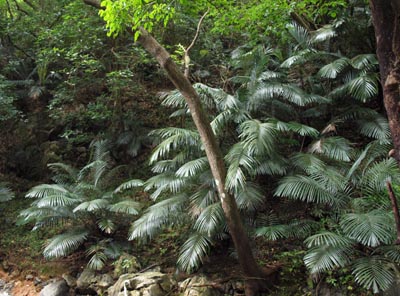Arenga ryukyuensis Information
A clump-forming, short, water-loving, moderately fast growing, monoecious palm with a hapaxanthic or monocarpic mode of growth where the plant dies after setting seed. Not known in cultivation, locally common in the wild. It has subterranean, black trunks, 2 m. (7 ft.) tall, 20 cm. (8 inch) diameter with no obvious leaf scars, and large segmented, pinnate (feather) leaves, 2 m. (7 ft.) long, 0.6 m. (2 ft.) wide, green above and, greyish green beneath.
This plant is suitable as a houseplant or conservatory plant.
Arenga ryukyuensis can survive freezing temperatures to about -6.5°C (20.3°F), but freezing is best avoided. This species naturally occurs on islands in moist forest, and is heavily effected by the surrounding sea temperatures, which are constant and often form sea mist and cloud. In this type of natural environment temperature fluctuations are slight, and this palm prefers a constantly mild climate with little temperature difference between day & night, and Summer & Winter. Under extreme freezing conditions we recommend you keep this palm as dry as possible, and well wrapped up.
Identification:
Stems short and subterranean except for flowering stems, these reaching 2 m tall, 20 cm diameter. Leaves pinnate; sheaths fibrous; ocrea net-like, sheathing, to 30 cm long; petioles to 1 m long, covered with felt-like, light brown tomentum and dark brown, peltate scales; rachis to 2 m long,
tomentose as the petiole; pinnae 32-48 per side of rachis, linear, strongly ribbed adaxially, notched along the distal margins, without ears at the base, or rarely ears present, regularly arranged and spreading
in the same plane except for the basal few pinnae, these paired; middle pinnae 43-59 cm long, 1.7-3.5 cm wide. Inflorescences interfoliar, unisexual, not seen in their entirety; staminate rachillae 26-37 cm long, 2.9-4.6 mm diameter, numerous, glabrous; staminate flowers 8-9.5 mm long, spirally and distantly arranged; sepals 2.5-3.5 mm long; petals 7.5-9 mm long; filaments 0.5-1 mm long; anthers 5.5-6 mm long; stamens 35-59; pistillate inflorescences pendulous; rachillae 16-31 cm long, 3.4-6.8 mm diameter, glabrous; pistillate flowers spirally and distantly arranged, 16-27 cm long, 5 mm diameter, glabrous; pistillate flowers 2.5 mm long; sepals 2 mm long, broadly imbricate; petals 2.5 mm long, valvate for ca. two thirds their length; fruits globose, 1.2-1.8 cm diameter, orange or red.
General Information:
This is a newly described species occurring in the Sakishima Group and Okinawa Group of Japan's Ryukyu Islands. Formally confused with Arenga engleri from Taiwan. The described differences are: Arenga ryukyuensis - Pinnae strongly ribbed adaxially, lobed along the distal margins only; filaments 0.5-1 mm long; stamens 35-59; Arenga engleri - Pinnae flat adaxially, lobed all along the margins; filaments 2-4 mm long; stamens 25-37;
However, our recent study of both the Japanese and Taiwanese Arenga in habitat has revealed different results (to be published later this year), the leaflets are variable and not good characters. Also the large seed size is not a good character (we found larger seeds in Taiwan). The species occurs from sea-level to about 350 m., but plants are very scarce at 300+ m elevation. Fruits ripen from green through yellow to red.
Distribution:
Native to, Japan
Ryukyu Islands (Sakishima Group, and Okinawa Group); lowland forest or secondary forest along river margins, or scrub forest especially near the sea shore, at low elevations. Several specimens are known from the Bonin Islands. However, the Bonin Island occurrences are from cultivation.
Location: Ryukyu Islands, Japan. (26.283964°N, 127.803268°E)

